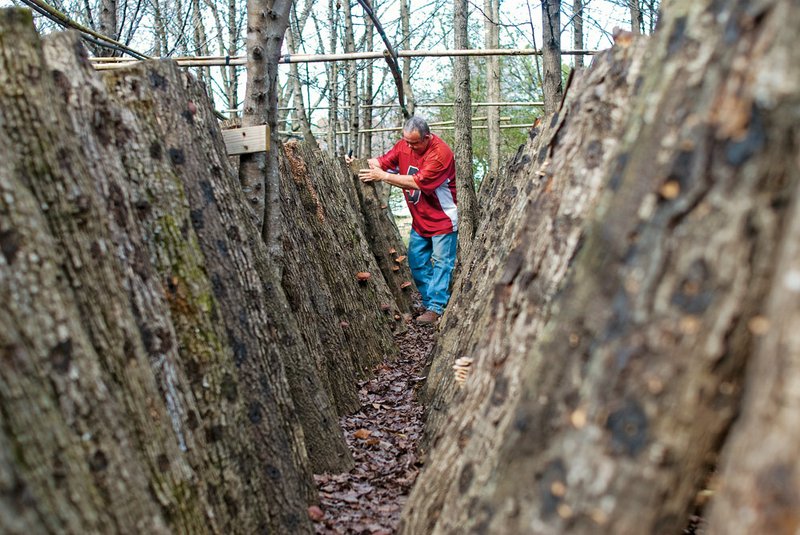Pop quiz time, no cheating: Where do mushrooms grow? Commercially, that is.
“Most people say caves,” said David Owens, co-owner of 3-Buddy’s Mushroom and Berry Farm near Searcy.
And they’re not wrong. Some commercially grown mushrooms are grown in temperature-controlled environments, or in big warehouses on bags of sawdust.
But Owens and his partners, David Sullivan and Mark Wood, do things in a more old-fashioned way on their farm. They use logs.
Each winter, the trio harvest white oak and other hardwood logs, each around 40 inches high, to grow mushrooms on through the spring, fall and early winter.
“In winter, the sap is down,” Owens said. “Sap is like white blood cells in humans. It attacks infection, and a mushroom is an infection to a tree.”
To grow mushrooms, the logs are drilled with shallow holes inches apart, staggered in a diamond pattern. The holes are filled with mushroom spawn with a large syringe and covered over in wax.
“Temperature is everything with mushrooms,” Owens said, “temperature and moisture.”
The operation currently grows two types of shiitake mushrooms, Snow Cap and West Wind. The Snow Caps fruit in November and December, while the West Winds fruit in March and April and again in September and October. Snow Caps grow best in 45- to 55-degree weather, while the West Wind variety prefers cooler nights and warmer days, around 50 degrees at night and 60 during the day.
Mushrooms grown by 3-Buddy’s are sold primarily at farmers markets, including the Searcy Certified Farmer’s Market and the Argenta Certified Farmer’s Market. The business also provides mushrooms directly to some area restaurants.
“We cater to a niche market, mushroom lovers,” Owens said. “You have to talk some people into buying mushrooms.”
Owens said that many people who come to their booth are only familiar with the white button mushrooms most often tossed in salads or put on pizzas. But shiitakes, Owens said, have a much richer flavor.
“Shiitakes have an earthy, nutty taste,” Owens said. “They’re often used as a hamburger or meat substitute, and they have a lot of protein.”
Because of the hot summer weather, the Searcy area is some of the farthest south that mushrooms can thrive outside, Owens said. But their limited growing seasons at first made it difficult to provide mushrooms to restaurants when they needed them. The farm began to use a technique called force-fruiting to get mushrooms on demand.
“You essentially trick them into thinking it’s spring by submerging the log in water for 24 hours and then hitting it with a hammer … which mimics the vibrations if a tree falls in a forest,” Owens said. “The mushrooms will start to grow so that they can get there before another species attacks the log. Fungus is an interesting thing.”
Owens and his partners decided to stop the practice because it was too hard on the logs. Now, they only pick when the mushrooms naturally fruit.
“Restaurants are starting to realize that if they’re going to use local food, it can’t be on demand and that it’s seasonal,” Owens said.
Last spring, during a severe drought, the logs supplied the farm with around 62 pounds of mushrooms. The spring before that, it was closer to 500 pounds.
“There was a drastic difference with the drought,” Owens said.
Soon, the team plans to add oyster mushrooms, grown on bags of straw, to make their farm go year-round.
In addition to mushrooms, 3-Buddy’s grows blackberries and experiments with a few unusual items such as Chinese red noodle beans and Thai golden round cantaloupe.
“At first, we were strictly mushrooms, but it got lonely sitting there at the farmers market with just your little box of mushrooms,” Owens said. “As the mushroom farmers, we try to bring the odd things to the market.”
Owning a mushroom farm never would have occurred to Owens, Wood and Sullivan a few years ago. The trio had met more than 20 years before while working at a Kohler plant.
In 2008, the three were sitting around talking about the possibility of not having Social Security funds to get them through retirement. Owens had recently visited the Shiitake Mushroom Center in Shirley to learn more about mushroom growing for himself, and the friends thought it would make a great side business.
“It’s taken some reading and a lot of trial and error,” Owens said.
The low-hanging bamboo irrigation system the friends set up for their farm was one of those experiments. While it does its job of keeping the shorter logs moist, it gets in the way during harvests.
“Anytime we bump our heads, we think, ‘What a stupid idea,’” Owens said.
After just a few years in the business, Owens already speaks like an expert, easily determining which category (button, stuffer or griller) his mushrooms fall into, or why a mushroom looks lumpy (tough bark) or cracked (cold weather).
“People will come up to me, trying to test if I know the difference between our shiitakes and a poisonous mushroom,” Owens said. “Yes, I really do. I can definitely tell the difference.”
Staff writer Emily Van Zandt can be reached at (501) 399-3688 or evanzandt@arkansasonline.com.
